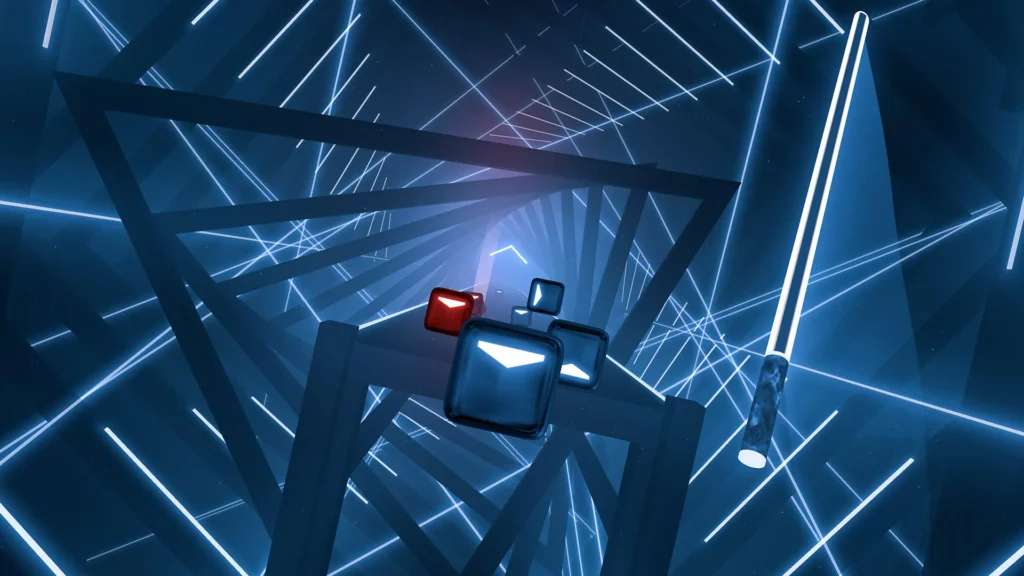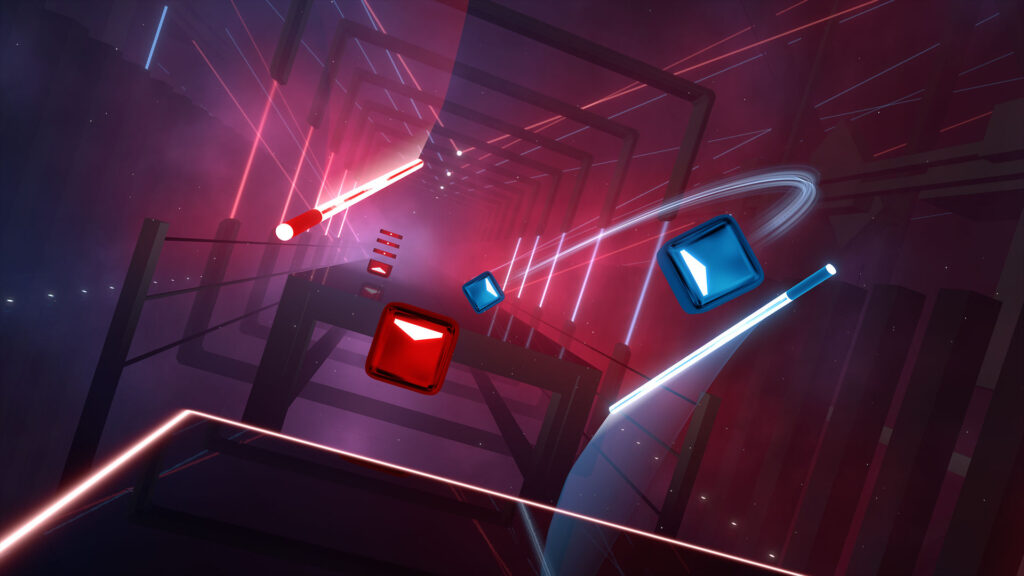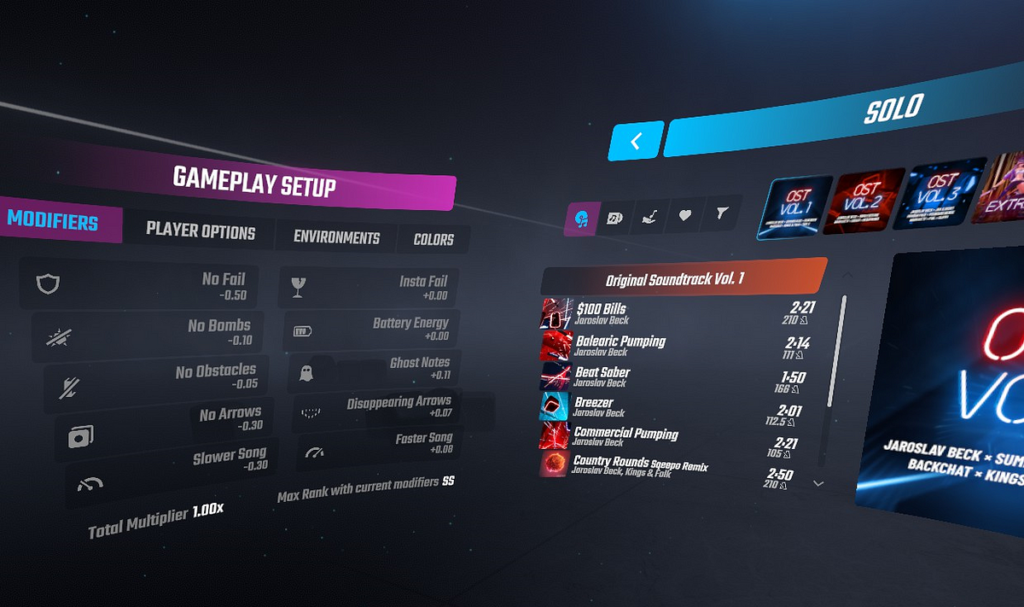Virtual reality has always been an interesting sticking point for the video games industry. In concept, it seems like the final frontier; true, unhindered immersion into a virtual world, controlled by the same sweeping movements that we use to navigate real life. However, the road towards that ideal has been long and rough. Immersive controllers are expensive and require bulky headsets to use, and the results rarely live up to the expectations built on films like The Matrix and Ready Player One. Despite the incredible, exponential growth of the industry over the last decade, virtual reality has continually struggled to find an audience that truly resonates with it. That is, with a few major exceptions.
Beat Saber, originally released on Steam in May of 2018, is one such case. Developed by Beat Games, a paltry team of three based in the Czech Republic, the game was a passion project that initially seemed highly unlikely to succeed. VR as a platform was even smaller than it is now, and there had yet to be a true breakout hit in the space. However, looking back at it with hindsight, it’s hard to believe there was ever any doubting the team and their concept.
Seven years after the initial launch, Beat Saber has sold more than 4 million copies and raised $250 million dollars in revenue (as reported by the Wall Street Journal in April 2023). This easily makes it the highest grossing VR game ever released, and that’s with numbers that are almost certainly out of date. The game now includes high-profile collaborations with artists like Metallica, Britney Spears, Daft Punk, and BTS among dozens more, and has an active community that’s still playing and creating to this day.
But what is it about this simple rhythm title that made it catch fire, and how did a fledgling independent studio pump out enough content to keep it alive even seven years later?

It’s hard to find a game more simple than Beat Saber. As you stand on a blank black stage, colored blocks will fly forward to the beat of a music track, and it’s your job to hit them with swords that take the place of your controllers. Red blocks are for the left hand, and blue blocks are for the right hand. There’s no need for buttons or anything more complex that the occasional wall or spike block to dodge; it’s that easy.
However, “easy” certainly isn’t how it feels in motion. The blocks often require twitch reflexes to hit, and you’ll only be able to see a short way ahead to prepare. Combine this with the disorientation of having objects flying directly at your face, and it’s easy to see how the game lends itself to a massive skill ceiling.
All it takes is one look online to see the insane feats of dexterity players are capable of. The speed and precision that the game demands at its hardest feel nigh impossible at a glance, but with enough practice, the results are surprising. Some even claim to enter a zen-like flow while playing, moving without thinking as they enjoy the music. It’s a phenomenon rarely ever achieved in games (the only other notable example being the “Tetris Effect”), and to have something like that available in VR is a massive accomplishment for the medium. It’s no exaggeration to say that Beat Saber is for VR what Tetris was for mobile gaming.

But none of that really would matter if the song selection wasn’t good, and that’s where Beat Studio ran into a problem. With such a small team of independent creators, the idea of generating large amounts of high-quality music on top of the game itself was a very tall ask. Thankfully, they found a way to have their cake and eat it too: they relied on their community.
Only a year after the game’s initial launch, custom-designed songs were enabled as a feature within the game. With enough effort, anyone could include any song they pleased, and that’s when Beat Saber really exploded. It was no longer about the paltry selection of included original songs (though those are pretty good themselves), it was about the tens of thousands of user-generated tracks constantly flooding the forums.
After seven years on the market, you’d be hard pressed to find an artist that doesn’t have at least some representation on Beat Saber’s community catalogue. From the most iconic bands of all time to the most obscure EDM sets, there’s likely a song to meet every taste. When placed alongside such a simple, dance-adjacent game, there’s almost no limits to its potential audience. If you enjoy grooving to music, you can enjoy Beat Saber.

And once the floodgates had opened, the rest was history. It may not have risen to the heights of the all-time indie greats, but anyone who owns a headset surely know the name. The only real issue was (and still is) the ease of access. To experience the true heights that Beat Saber has to offer, you not only need a decently strong computer and a VR headset, but also the proficiency to download and install mods for each song you want to play. It’s not impossible, but even as someone who has everything they need to do it, I still struggle to justify the effort needed to play. If there’s one thing a potential sequel should fix, it’s that lack of ease.
The art style may be simple and the interface basic, the initial selection mild and hardware expensive, but if you can get past that, Beat Saber’s quality is undeniable. The fact so many continue to play in spite of the hurdles is a testament to the strong core of the game’s design, and it still holds a special place in my collection as a result. There is no other experience quite like Beat Saber, and in an industry increasingly dominated by safe, sterile triple-A releases, that means more than ever.
If you have the means or are looking to try VR, I encourage you to put in the effort and give this game a shot. It may not be for everyone, but for those it does click with, it just might justify your headset purchase all by itself. This isn’t a review, but if it was, I’d probably say this: Beat Saber is one of the most unique gaming experiences you’ll see this generation. It’s not flashy, it’s not eloquent, and it’s not particularly complex, but what’s there is something that’ll have you dancing from dusk to dawn.

